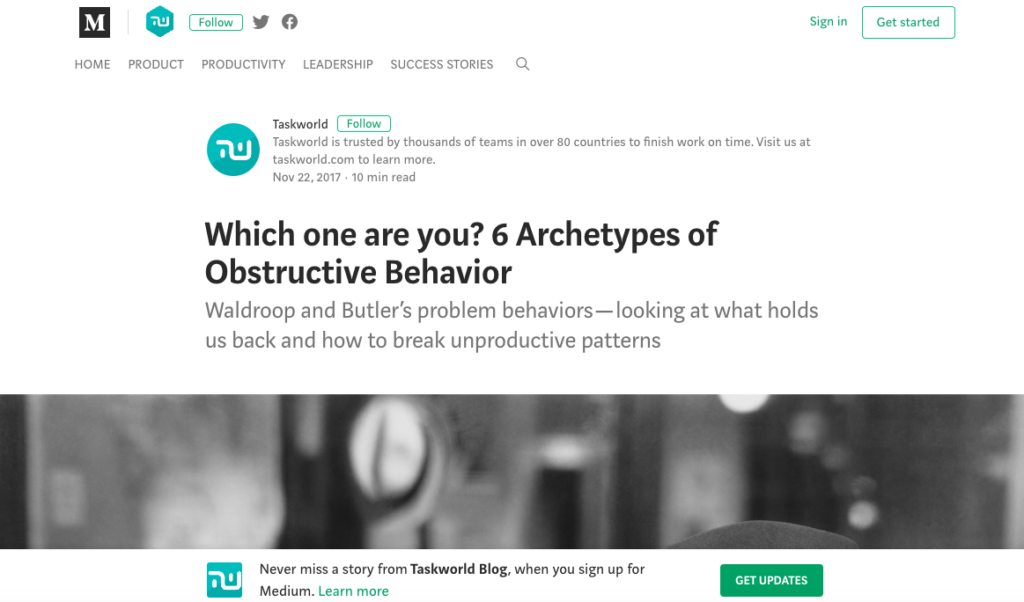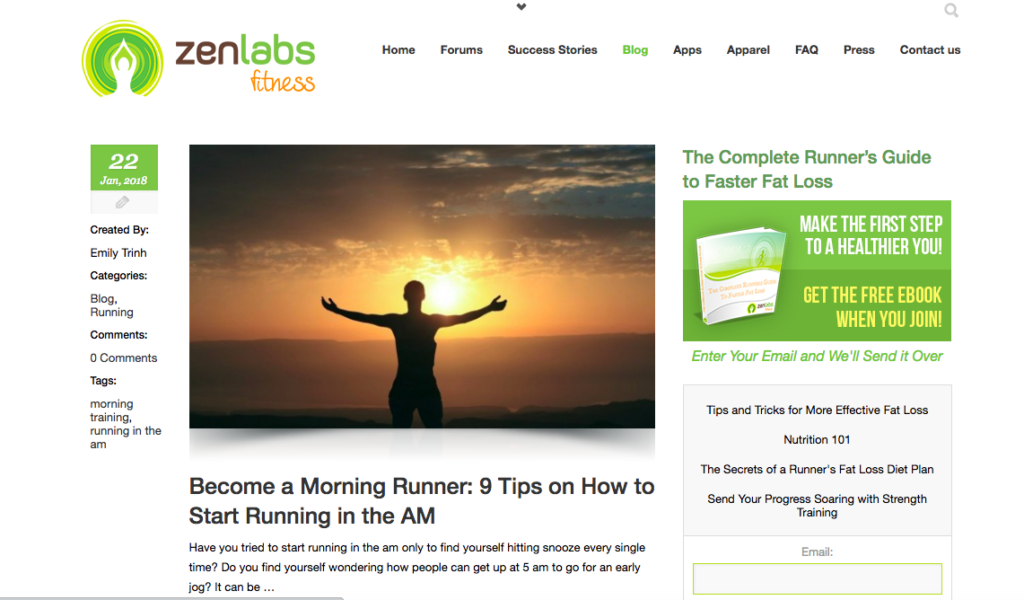
No doubt getting a startup off the ground is hard work, so why add one more thing to your list? Because you like effective marketing, and blogging, for startups and even for established businesses, will give you an ROI for years to come.
Not too long ago, I was searching for an air purifier. I live in New England, where the summers are beautiful, but winter is long and cold. For obvious reasons, my home is closed up tight for those bitterly cold months. The storm windows are down, fans are tucked away in closets, and the curtains are closed for longer. Even with the most fastidious cleaning regimen, it gets stuffy over the course of those four or five months until we can again open the windows. Add in several people and a few pets all sharing the space, and you can see why an air purifier might be necessary.
This is where blogging for startups – especially startups without big marketing dollars – comes in. Stick with me here.
There are dozens of brands and hundreds of models of air purifiers to choose from. Even after narrowing the list down based on price, quality, needs, and availability, there were still dozens of choices. What helped with the final choice was a blog post that was a couple years old at the time. “What Is a HEPA Air Purifier?” (along with several other posts on the Rabbit Air’s Air Quality Blog) made our choice clear, and a Rabbit Air BioGS now sits in our home. Even today, a Google search for the exact phrase, “what is a HEPA air purifier,” brings up this 2014 article first out of almost 8,500 articles.
Rabbit Air isn’t a startup, but there is a valuable lesson here about efficient and effective marketing. Smart, helpful blog posts based on an organic search-focused strategy have an exponential impact on your marketing budget. In other words, the cost of each blog post goes down every time someone clicks on it. And if you do it right, each post may get clicks for years to come. Here are some facts to prove the point.
Blogging for startups: Is it really worth it?
Only you know what it takes to make any marketing “worth it.” Even “free” marketing, like social media, takes time and energy if you want to connect with your customers. A pay-per-click ad may give you a big jump in traffic, but once the money runs out, that traffic dwindles quickly. Blog posts (a big part of content marketing), on the other hand, might be the only marketing tool that gets less expensive the more it gets used.
In one study by Kapost and Eloqua, researchers found that content marketing has an 80% drop in cost-per-lead over a five month period.
A study by Hubspot found that publishing 16 or more blog posts per month (an average of two per week) will give you 3.5 times more website traffic than if you don’t post or post less than once per week.
Hubspot researchers also discovered that companies publishing blog posts get 55% more visitors and 97% more inbound links as compared to companies that don’t blog.
Website visitors are great, of course, but what you really want is visitors who will eventually become customers, so strategy is a very important part of blogging for startups. You could get a lot of visitors writing about the best places to eat when you visit San Francisco, and if you’re marketing a healthy eating app or a travel agency, that could be relevant. But if you’re a tax software company, that traffic won’t be very beneficial to you (although “How to write off business travel expenses” could be).
So does blogging for a specific audience pay off?
In our own research, we’ve found that, on average, our clients get 70% or more of their leads through blog posts. Combine these blog posts with a social media promotion strategy, and you’ve combined two powerful marketing mediums. At one point, one of our clients brought in more leads through their blog and social media than all but two of their salespeople.
But what to write about and how to do it? Well, there are a lot of ways to approach this, but the very short version is to find a keyword* that your audience is looking for, write a blog post around it, then promote it on your social media channels. Here are some examples from seven different industries.
*A keyword or phrase is what you type into the Google search bar when you look something up.
Blogging for startups: How to write blog posts that will reach your audience
There are four things you need to do to reach your audience through blogging.
- Determine who your audience is and write directly to them. (The post you’re reading right now is written for startup companies that are looking for ways to market themselves.)
- Write a post using the keywords or phrases your audience is looking for. (For example, the keyword phrase for this post is “blogging for startups.”)
- Include helpful, relevant content. (Hopefully you find some of this content interesting and helpful.)
- Promote your content. (Follow us on Twitter and you’ll see promotional Tweets about this blog post.)
For each of the ideas below, there are keywords (in red) that have good search volume and low competition. There are also potential blog titles with the keywords, as well as a suggested call to action (CTA – hey, you do want readers to click on your sales page, right?). Finally, there are examples from other companies who are already making some waves with their blogs. You are welcome to use these (the keywords and CTAs – not the examples) for your blog – or you could hire us and we’ll do it for you.
Blogging for startups: 7 content marketing ideas you can make your own
1. The travel bag startup
Title: How To Pack for a Semester Abroad
Suggested Call to Action: Whether you’re figuring out how to pack for a semester abroad or just your daily commute, packing the essentials is a lot easier when you have the right bag. Check out the latest on our products page.
There is no shortage of events to pack for, and Tortuga Backpacks offers an array of packing tips on their blog. In “How to Build a Digital Nomad Capsule Wardrobe” they offer practical tips for packing light. They also include a “soft sell” call to action at the end of the post. Sign up for their email list and get a free carry on packing list. Giving something away is always a good CTA.
2. The coffee enthusiast startup
Title: The Best Way to Brew Coffee at Home
Suggested Call to Action: Learn the secrets your barista doesn’t want you to know. The coffee recipe app shares insider’s tips on the best way to brew coffee at home, and bring your buzz to a new level.
Looking for great coffee? The Beanhunter app plugs you into the best coffee, no matter where you are. They know their audience will look for good coffee wherever they travel. They also share ideas on making coffee at home, which perfectly complements their coffee subscription club. Their blog IS their call to action. It also doesn’t hurt that there is a popup for a discount on your first order.
3. The budgeting or finance app startup
Title: The Best Way to Save for a Car (Without Spending Every Weekend at Home)
Suggested Call to Action: This easy-to-use budgeting app might be the best way to save for a car, get out of debt, and make your money work for you. Try it free for 45 days; it’s like putting money in your pocket.
Personal finance is cool these days, and apps with blogs like You Need a Budget (YNAB) make it abundantly clear. YNAB posts regularly about saving money, paying down credit card debt, working with the money you have, and almost anything else related to personal finance. They do an excellent job of blending stories into budgeting tips, leading to… you guessed it: a soft call to action.
4. The home office app startup
Title: How to Develop Concentration and Stay Distraction-free at Work
Suggested Call to Action: Don’t let life’s little distractions impact your work. Try our home office organization app free for 30 days and find out why learning how to develop concentration is easier than you think.
Taskworld has a blog full of productivity tips, leadership ideas, and, in a deft marketing move, success stories with a focus on customer stories. It’s a smart way to tout your product and make your audience feel involved. (Who doesn’t like a little shout out now and then?) They end each blog post with a nice embedded link so readers can sign up for a free trial.
5. The exercise app startup
Title: Training to run a 5k: A Beginner’s Guide to Running Fitness
Suggested Call to Action: Don’t run your next race alone. Whether you’re training to run a 5k or you just want to get moving, thousands of runners have used this exercise app to guide them from couch potato to running their first race. Best of all, it’s free!
The Zen Labs fitness blog tackles everything running related. From knee injuries to increasing your distance to breathing tips for beginners, their blog is robust, with posts going back to 2014. Their call to action is to sign up for their email list in return for a free ebook. They take the long view – turn your visitors into community members, some of whom will eventually opt for your premium products.
6. The fitness tracker app startup
Title: How Can I Sleep Better? 5 Ways to get your Zzzz’s
Suggested Call to Action: Feeling drowsy during important meetings? Is the alarm clock your enemy? You might not be sleeping well. The sleep cycle app tracks your sleep, offers suggestions for improving the quality of your sleep, and includes tips and ideas for meals and activities that will help you reset your sleep. Try it free for 20 nights.
The Sleep Cycle Alarm Clock helps you wake up when your body is ready. There is one thing they do particularly well with their blog: they back up statements with facts. For instance, when they say, “Studies show that people who are sleep deprived have a shorter lead up time to exhaustion than people who stay on top of their sleep schedule,” there is a link to the original study. For opinion posts (like A Small Business Saturday Roadtrip), this may not be important, but when you’re sharing facts about health and fitness, your credibility is one of your selling points.
7. The travel agency startup
Title: The 5 Best European Cruises for Budget-minded Travelers
Suggested Call to Action: Don’t miss your chance to visit some of the most renowned ports in Europe. These are the best European cruises you’ll find, and you won’t believe the price tag! We can help you find the best deals and even make dinner reservations for you. Call us to find out more.”
Any vacation can get overwhelming if you don’t know what to expect. Smart travel agents know this, and their biggest selling point is guiding customers through the multitude of options to design the best vacation possible. Using your blog as a tutorial is a great way to do just that. Liberty Travel has a little bit of everything on their blog. There are plenty of ways customers can learn about new destinations, what to expect on vacations, and spotlights on some of their travel agents. There’s almost no way to go wrong with a travel agency blog.
There are as many possibilities for startup blogs as you can imagine. Hopefully these seven will give you a place to start. And in case you want more, you can check out: Blog post ideas for CRM Companies, Standing Desk Companies, Tax Software Companies, Accounting Software Companies, Payroll Software Companies, and Help Desk Startups.
Does writing your company blog seem like a task you’d rather not deal with? We love blogging for business. Join us to get the benefits of a professional team dedicated to your success.














